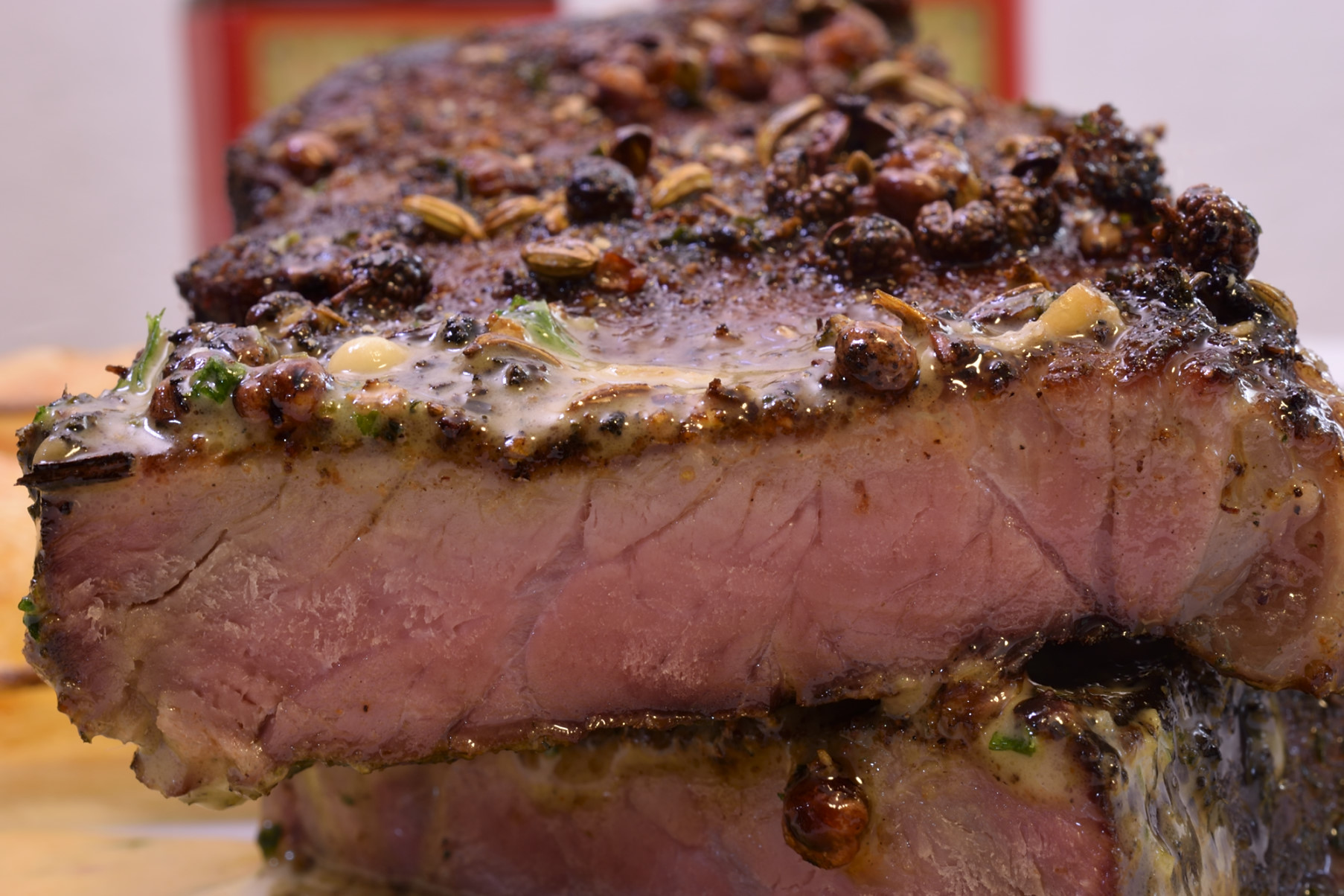Sous-B-Q: Beef Strip Loin Roast, "Nerve End"--2020
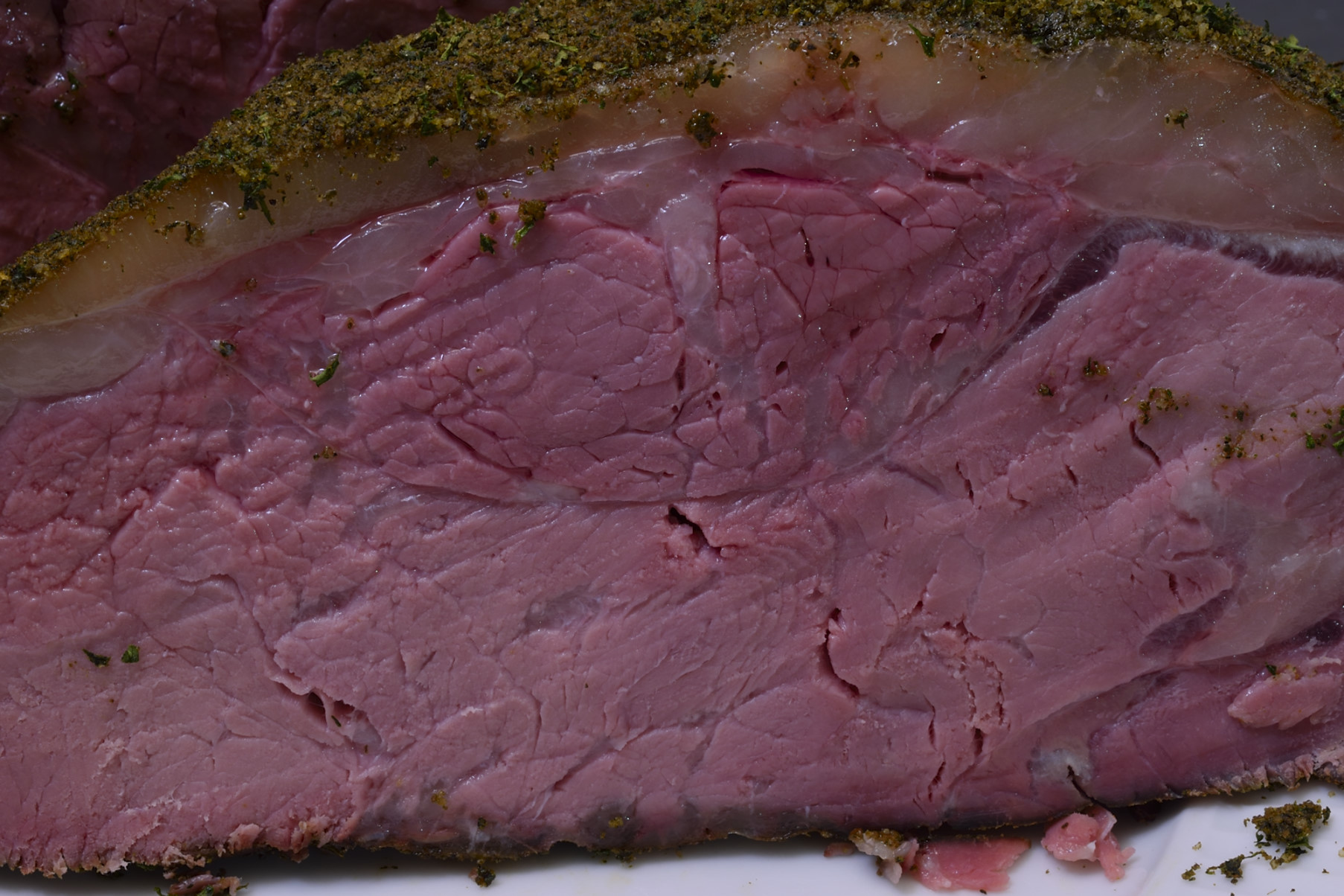
About
While derived from an inherently tender primal cut, the New York nerve/vein end is extremely gristly and requires special treatment.
Ingredients
Beef strip loin, VEIN END, approximately 4.5 lbs/2 Kg.
Egg whites, 1 each, beaten vigorously with a fork.
Seasonings, your choice or one of our proprietary blends linked HERE.
In this model, we used our Green Machine blend and our Cajun Black Spice.
Equipment requirements
Immersion circulator, portable or stationary.
Lipavi heat rated container, minimum of 2 gallons/8 liters.
Lipavi L15 rack or equivalent.
Heat rated sous vide bags.
Paper towels.
Pellet smoker or conventional oven.
Cast iron broiler pan or thick bottomed skilled, approximately 12"/30 cm.
Instructions
Serves 4-6 Level of difficulty: 3
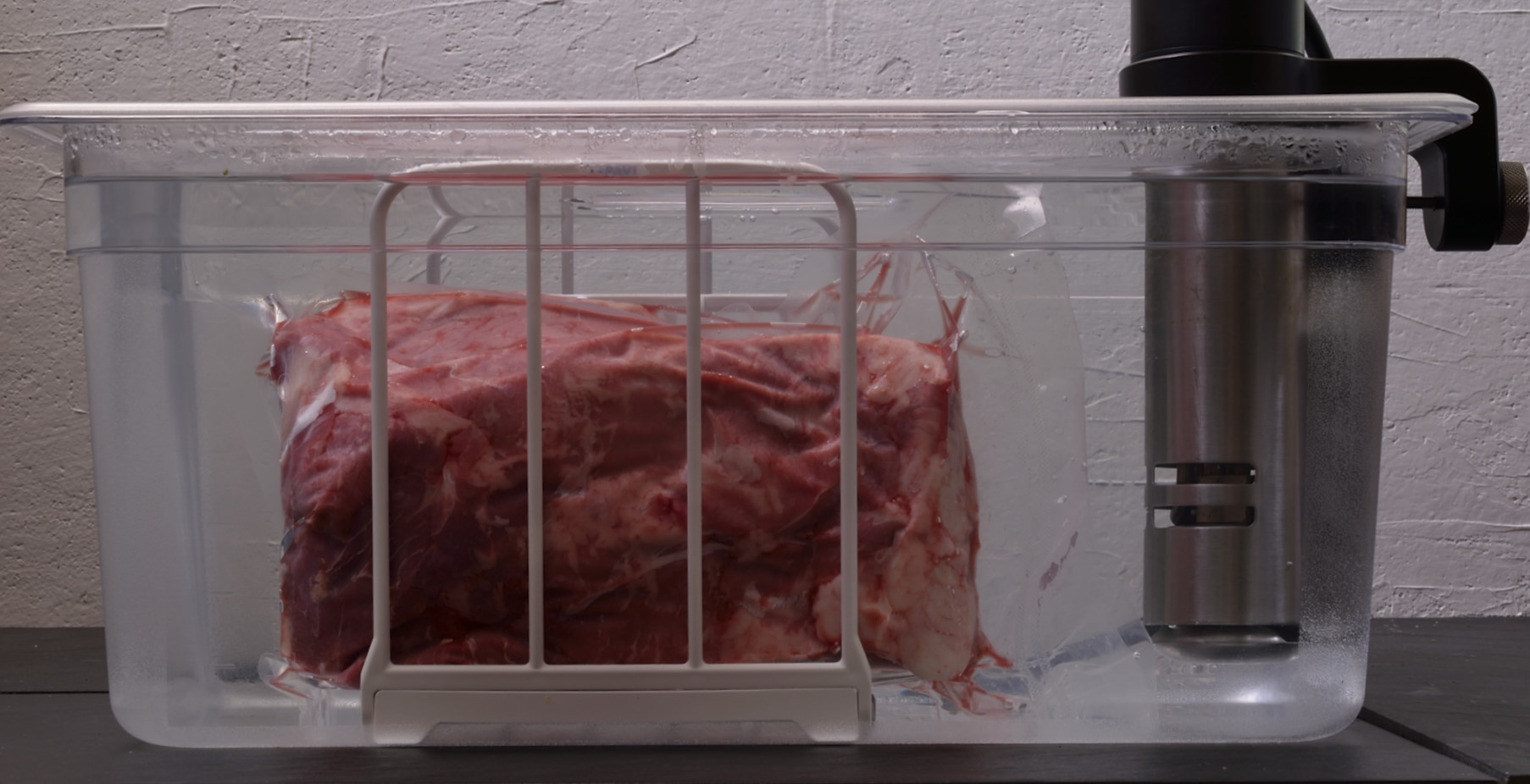
Identifying the nerve/vein end of the beef strip loin.
Below: whole beef strip loin, as seen from the (front) end that connects to the rib eye primal cut. This is called the longissmus muscle, and it extends from the shoulder of the animal all the way to the hip--usually 4-5 feet long.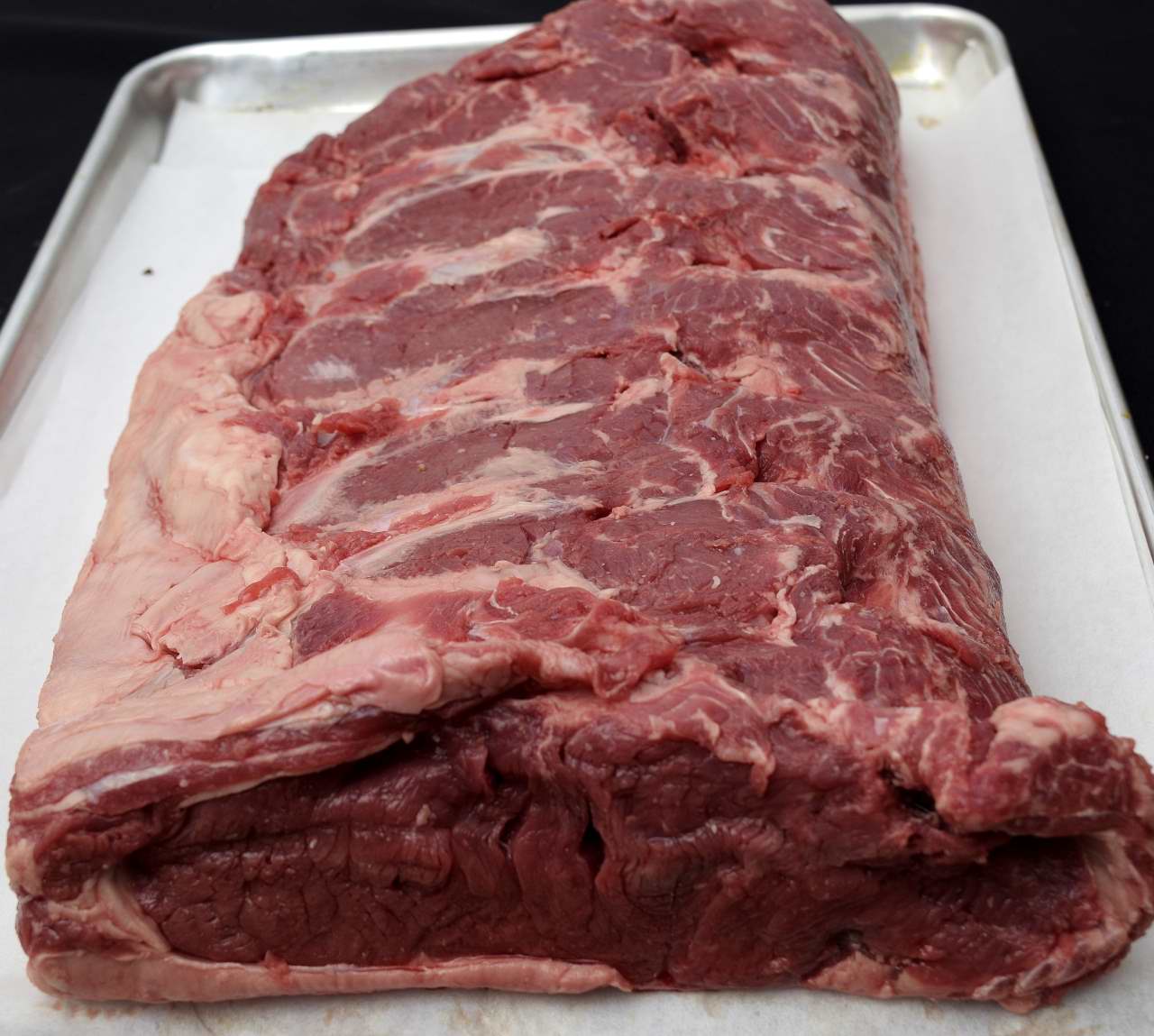 Below: whole strip loin, as seen from the hip end, where the muscle connects to the top sirloin sub-primal cut.
Below: whole strip loin, as seen from the hip end, where the muscle connects to the top sirloin sub-primal cut. 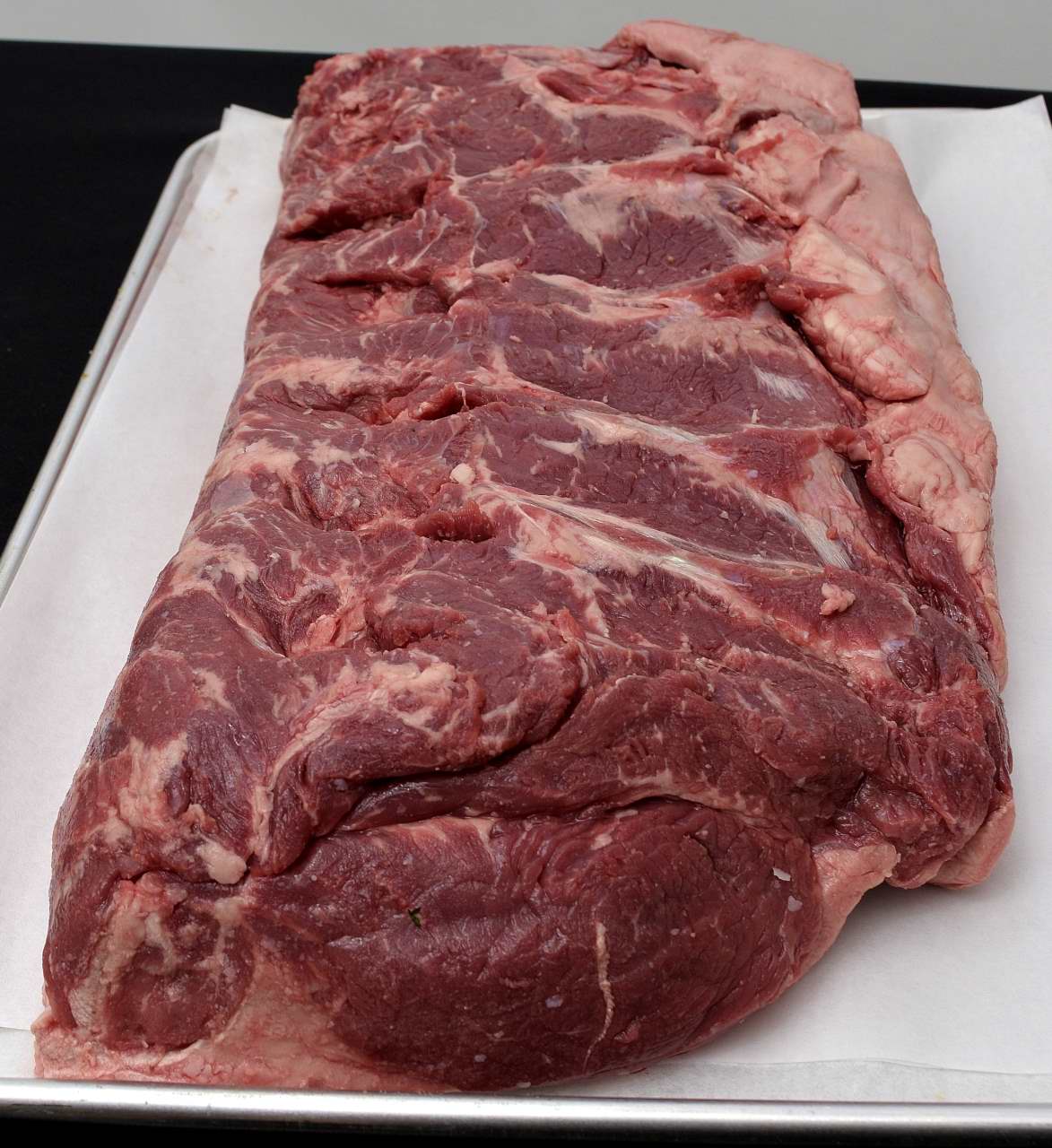 Above: you can see how the longissmus muscle has flattened out, while another oval muscle now protrudes into the cut--approximately 1/3 of the length of the strip loin--about 10".
Above: you can see how the longissmus muscle has flattened out, while another oval muscle now protrudes into the cut--approximately 1/3 of the length of the strip loin--about 10". 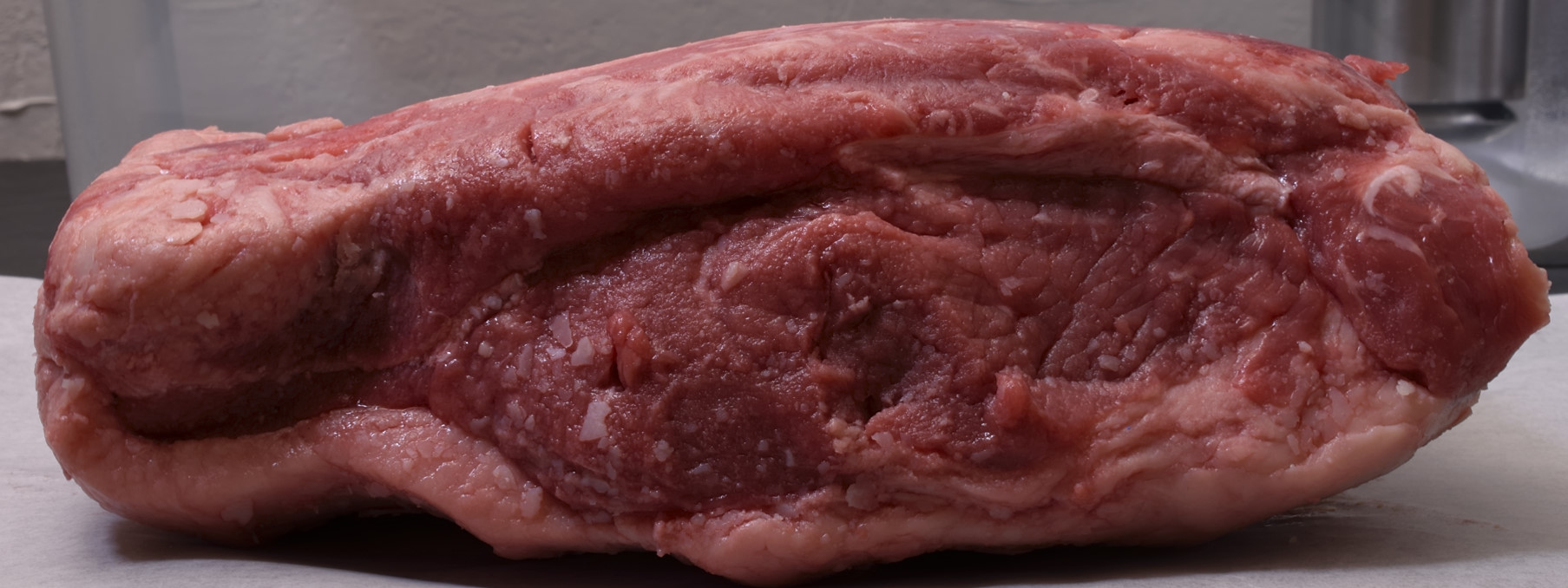 Above and below: the connective tissue between those two sections is very tough.
Above and below: the connective tissue between those two sections is very tough. 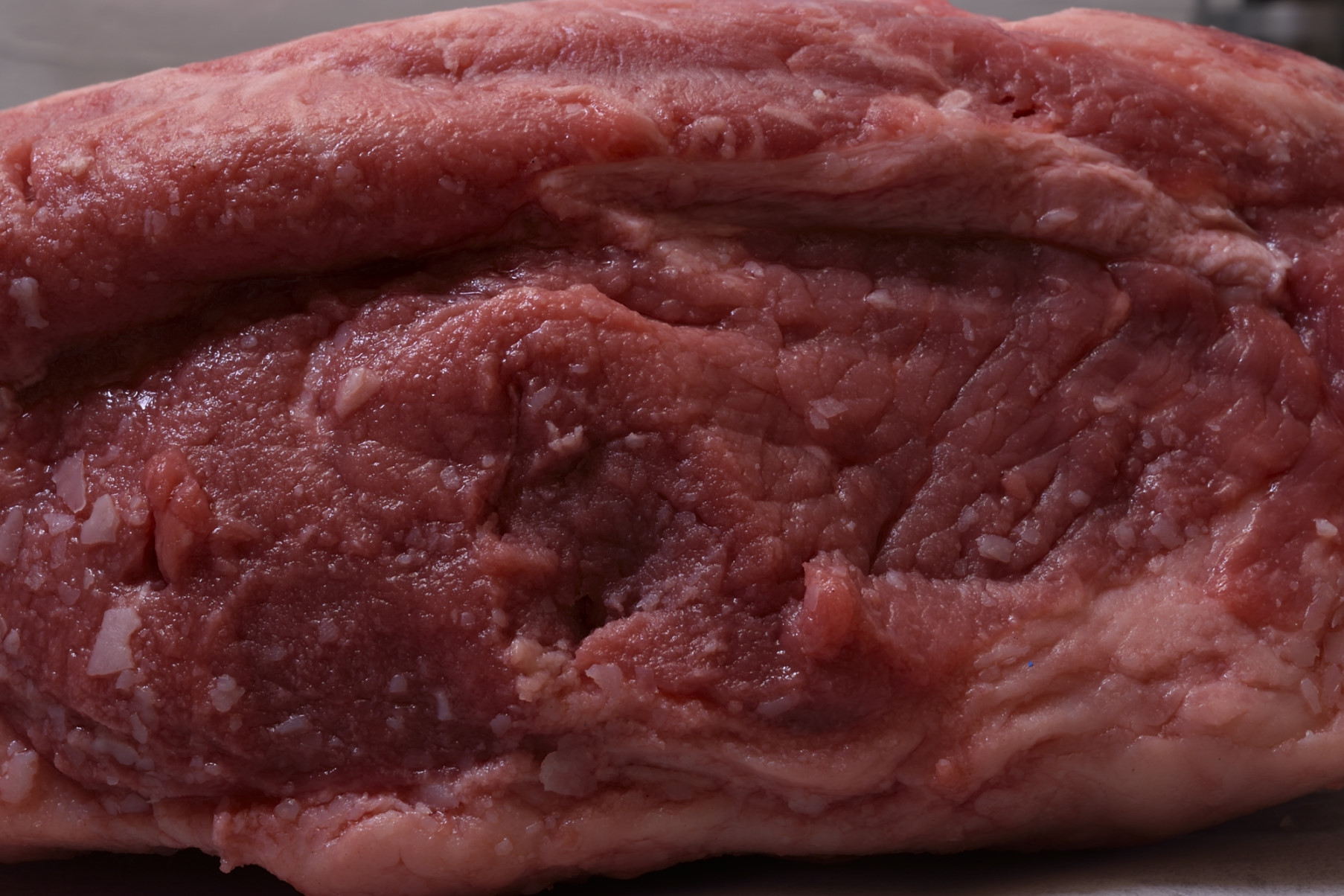 For an even more detailed explanation of exactly how to identify the nerve/vein end, visit HERE. Remove the nerve end from the rest of the strip loin. This involves a certain amount of guess work (the first time, anyway!) but the nerve end comprises about one third of the whole muscle.
For an even more detailed explanation of exactly how to identify the nerve/vein end, visit HERE. Remove the nerve end from the rest of the strip loin. This involves a certain amount of guess work (the first time, anyway!) but the nerve end comprises about one third of the whole muscle. 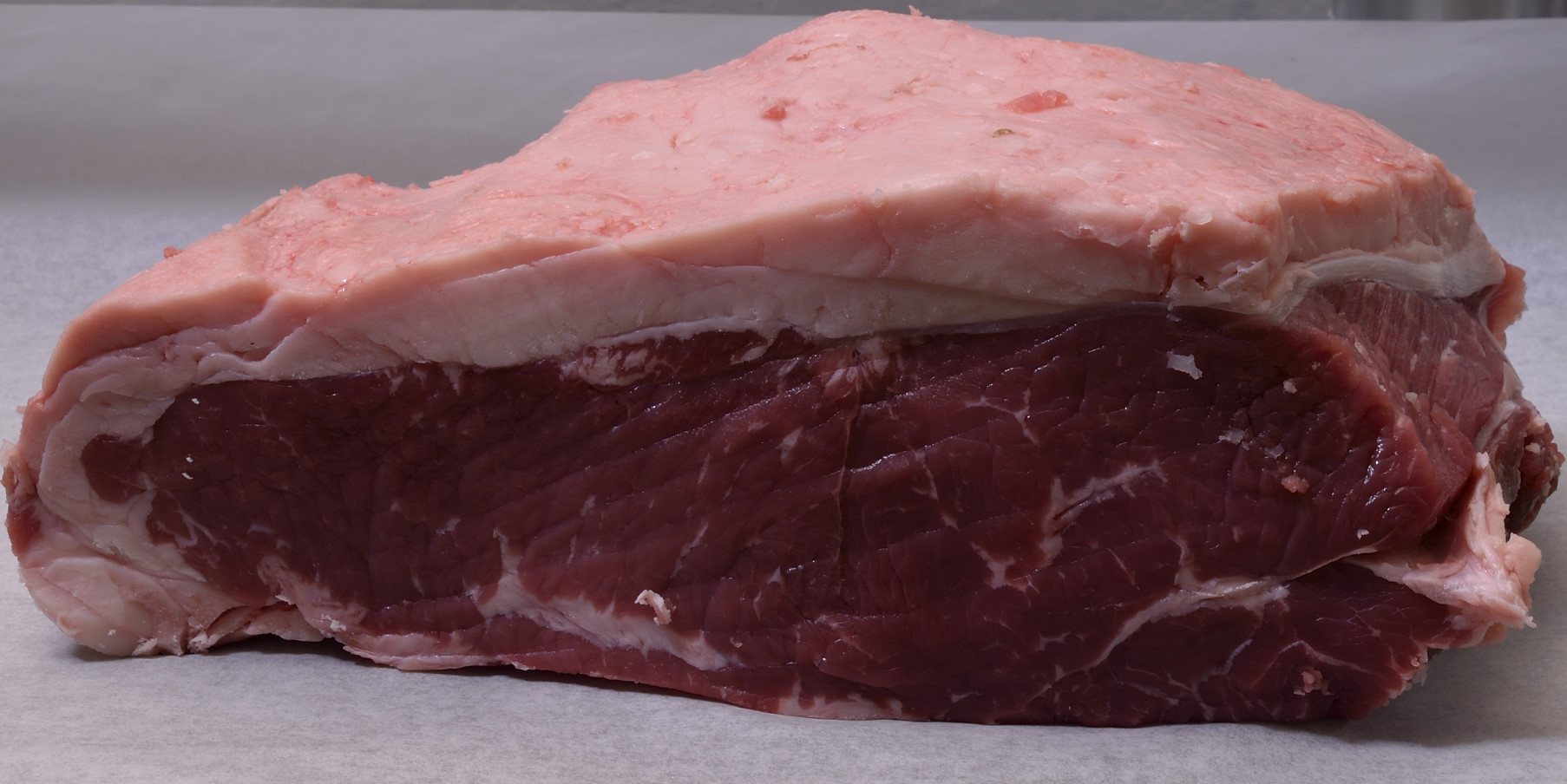 Above and below: if the cut is made precisely correctly, a very small reminder of the presence of the intruding muscle will be visible. If not, you'll get better next time! If you take too much, proceed as if you did it perfectly. If you take too little, again, proceed! There is a small learning curve!
Above and below: if the cut is made precisely correctly, a very small reminder of the presence of the intruding muscle will be visible. If not, you'll get better next time! If you take too much, proceed as if you did it perfectly. If you take too little, again, proceed! There is a small learning curve! 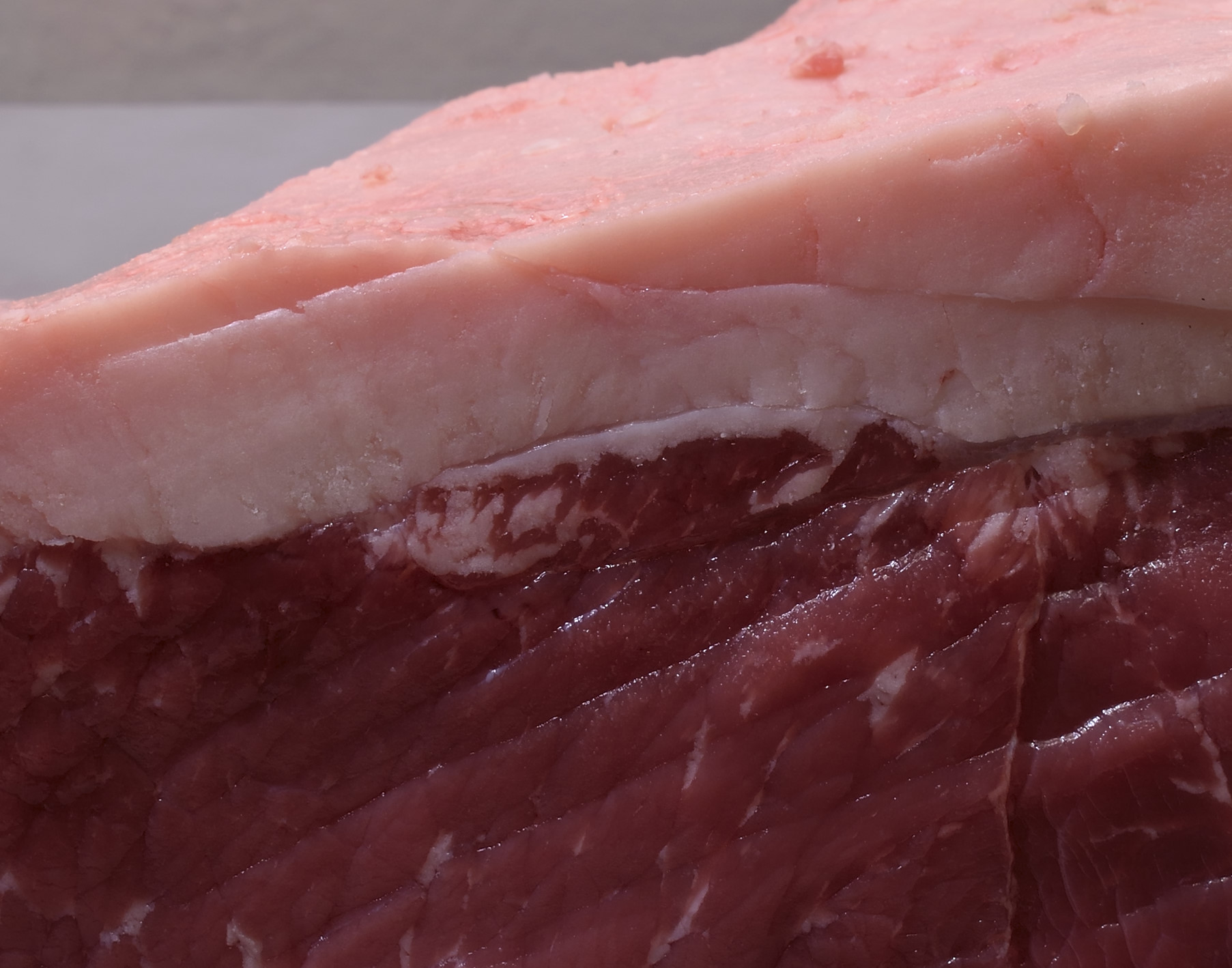
Procedure:
Preheat the sous vide bath to 129 F/53 C. Stage the nerve end roast into heat rated vacuum bags and process for 24 hours. This long interval is necessary to tenderize the exceptionally large amount of gristle in the cut.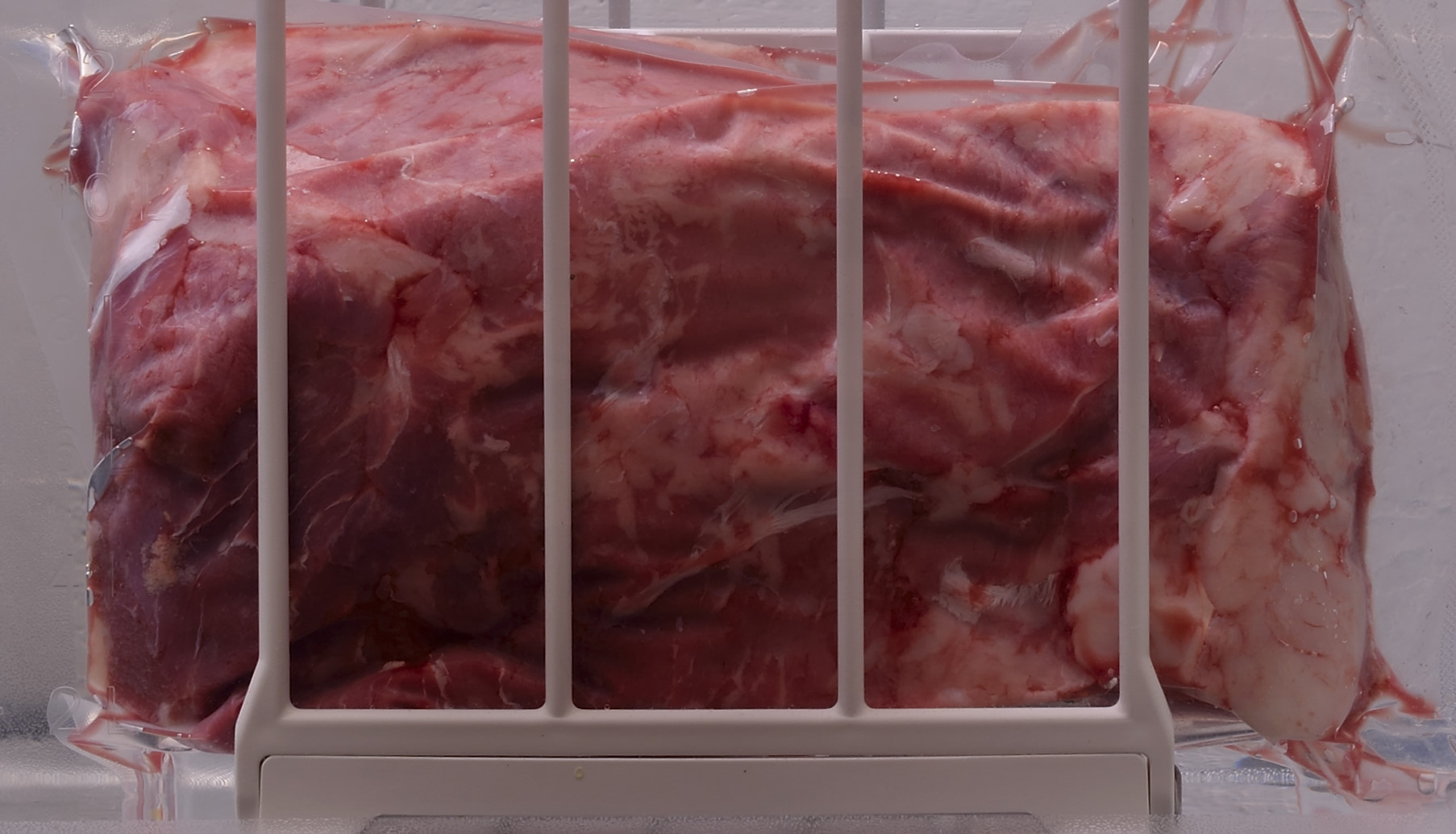 When the processing time has elapsed, shock the tenderized roast in iced water until it achieves 70 F/21 C. This is a very important safety procedure for roasts of this size--whether you are processing sous vide or not. A roast of this size should NEVER be cooled at room temperature--it just takes too long to meet established safety guidelines. Refrigerate at 40 F/4 C until you are ready to move on to the next step of smoking the roast. At that time, submerge the entire cold package for 5-10 minutes in a preheated sous vide bath or hot tap water (110+ F/44+ C). This will fully melt the gel. Cut one of the corners of the bag and drain the juices. Set aside. At your convenience, click HERE to learn how to clarify the juices for use in any recipe that calls for stock or water.
When the processing time has elapsed, shock the tenderized roast in iced water until it achieves 70 F/21 C. This is a very important safety procedure for roasts of this size--whether you are processing sous vide or not. A roast of this size should NEVER be cooled at room temperature--it just takes too long to meet established safety guidelines. Refrigerate at 40 F/4 C until you are ready to move on to the next step of smoking the roast. At that time, submerge the entire cold package for 5-10 minutes in a preheated sous vide bath or hot tap water (110+ F/44+ C). This will fully melt the gel. Cut one of the corners of the bag and drain the juices. Set aside. At your convenience, click HERE to learn how to clarify the juices for use in any recipe that calls for stock or water. 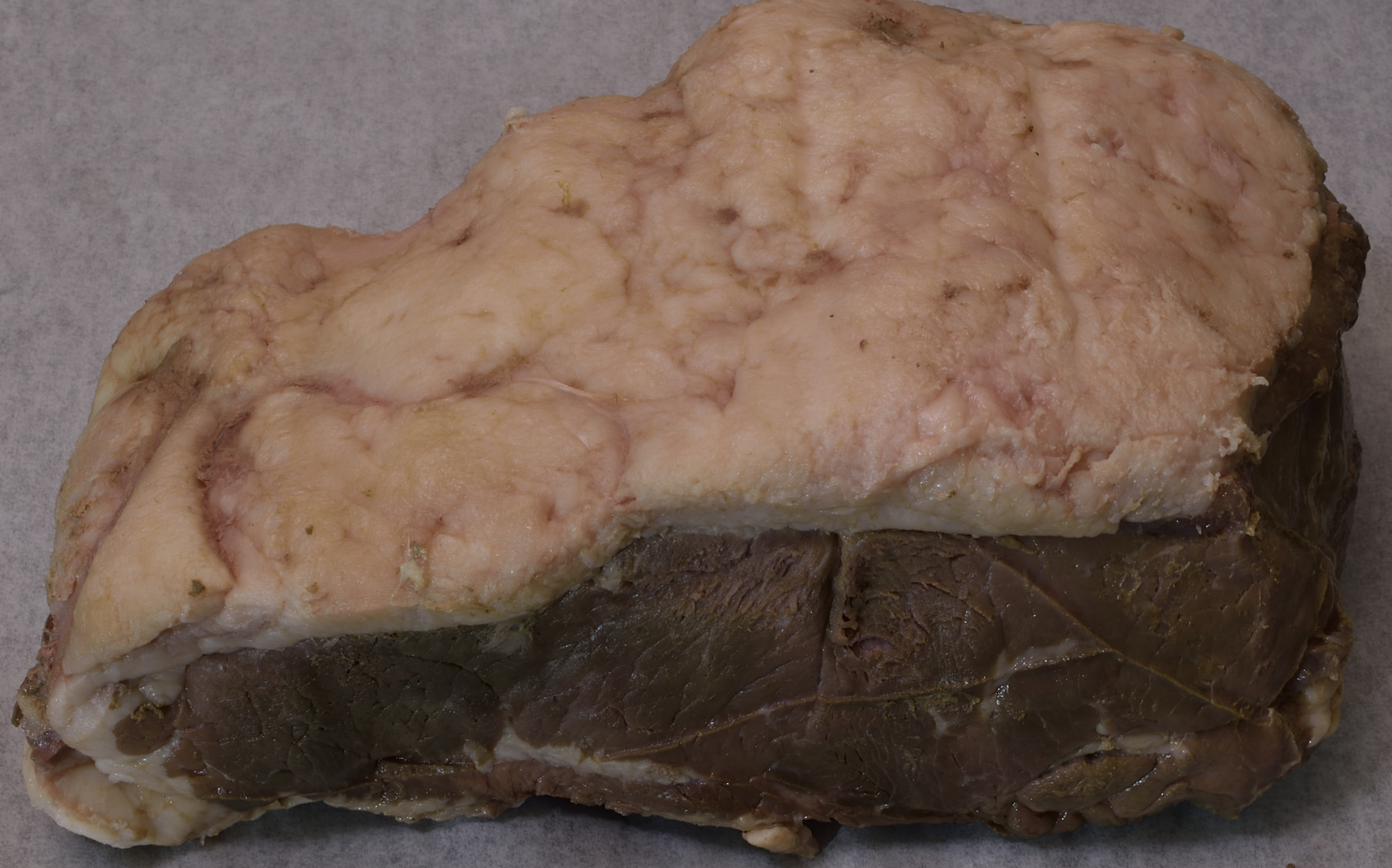 Finish opening the bag and remove the roast from bag. Pat the roast dry with paper towels. Place roast on a clean surface like a baking pan or parchment--or a baking pan covered with parchment! We are going to create a sticky surface so that our rub clings to the roast. Drizzle or brush the egg whites over the exposed surface of the roast.
Finish opening the bag and remove the roast from bag. Pat the roast dry with paper towels. Place roast on a clean surface like a baking pan or parchment--or a baking pan covered with parchment! We are going to create a sticky surface so that our rub clings to the roast. Drizzle or brush the egg whites over the exposed surface of the roast. 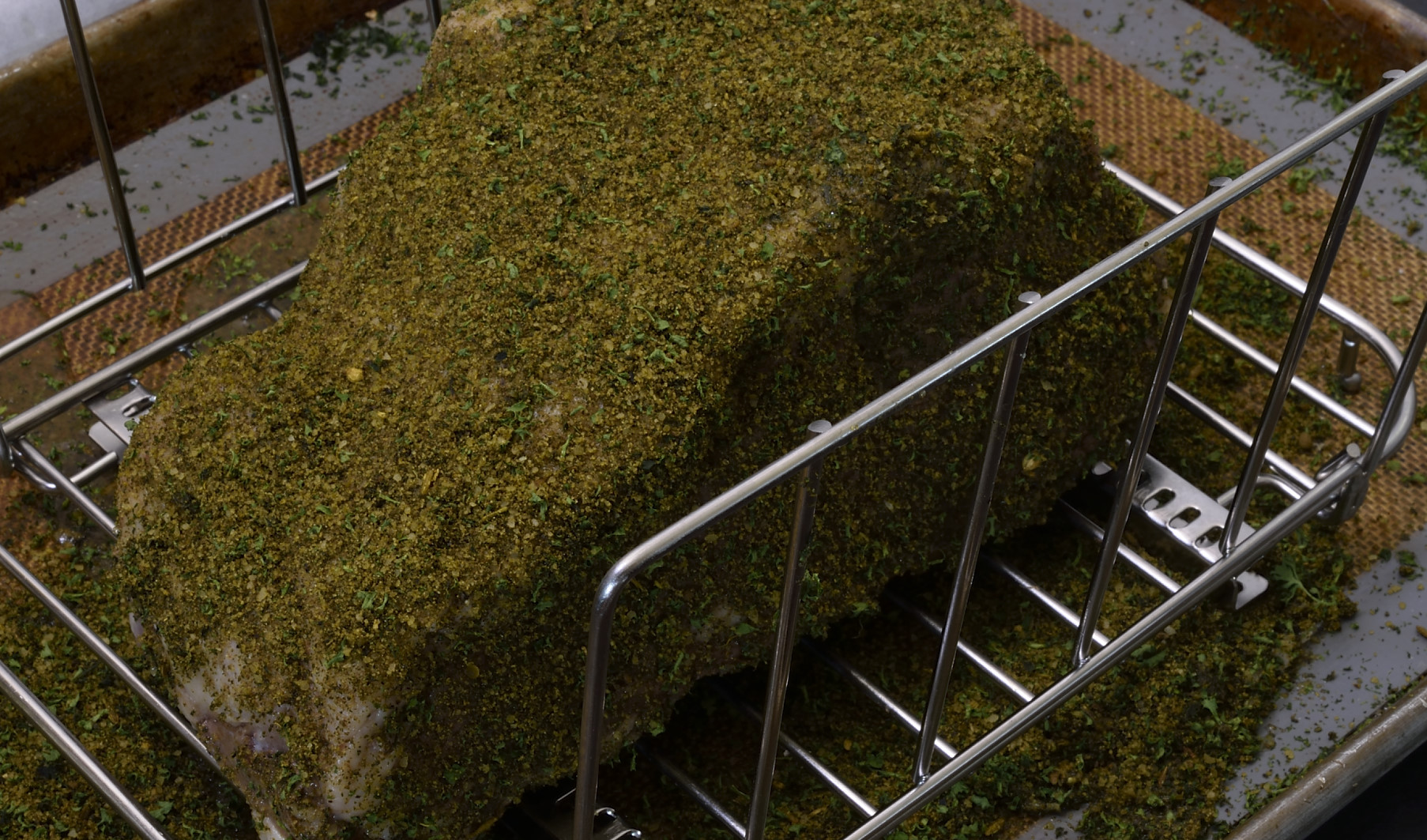 Sprinkle the rub generously over the exposed surface. Using dry hands, turn the roast over (and on its sides), repeating the application of the egg whites and rub until the roast is completely covered. Allow some rub to accumulate on the parchment/surface under the roast to prevent dislodging of the crust.
Sprinkle the rub generously over the exposed surface. Using dry hands, turn the roast over (and on its sides), repeating the application of the egg whites and rub until the roast is completely covered. Allow some rub to accumulate on the parchment/surface under the roast to prevent dislodging of the crust. Smoke
We use a PID driven pellet smoker but any smoker (or indoor oven) will work. The lowest temperature practical in these devices is usually 180 F/82 C Smoke the roast at this temperature for 4 hours--internal temperature of the roast should achieve at least 129 F/53 C--the same as the original target temperature. Remember: every time you open the lid, the smoker/oven loses about 100 F/38 C. It takes a smoker at least half an hour to recoup. Most back yard smokers have thermometers. Most people either never glance at them or do not even know what temperatures they want. There are inexpensive, wireless thermometers so you can monitor the IT remotely from the comfort of your BarcaLounger in front of the television. Take advantage of the technology! And, again, remember: even at 350 F/176 C the roast would not burn in two hours.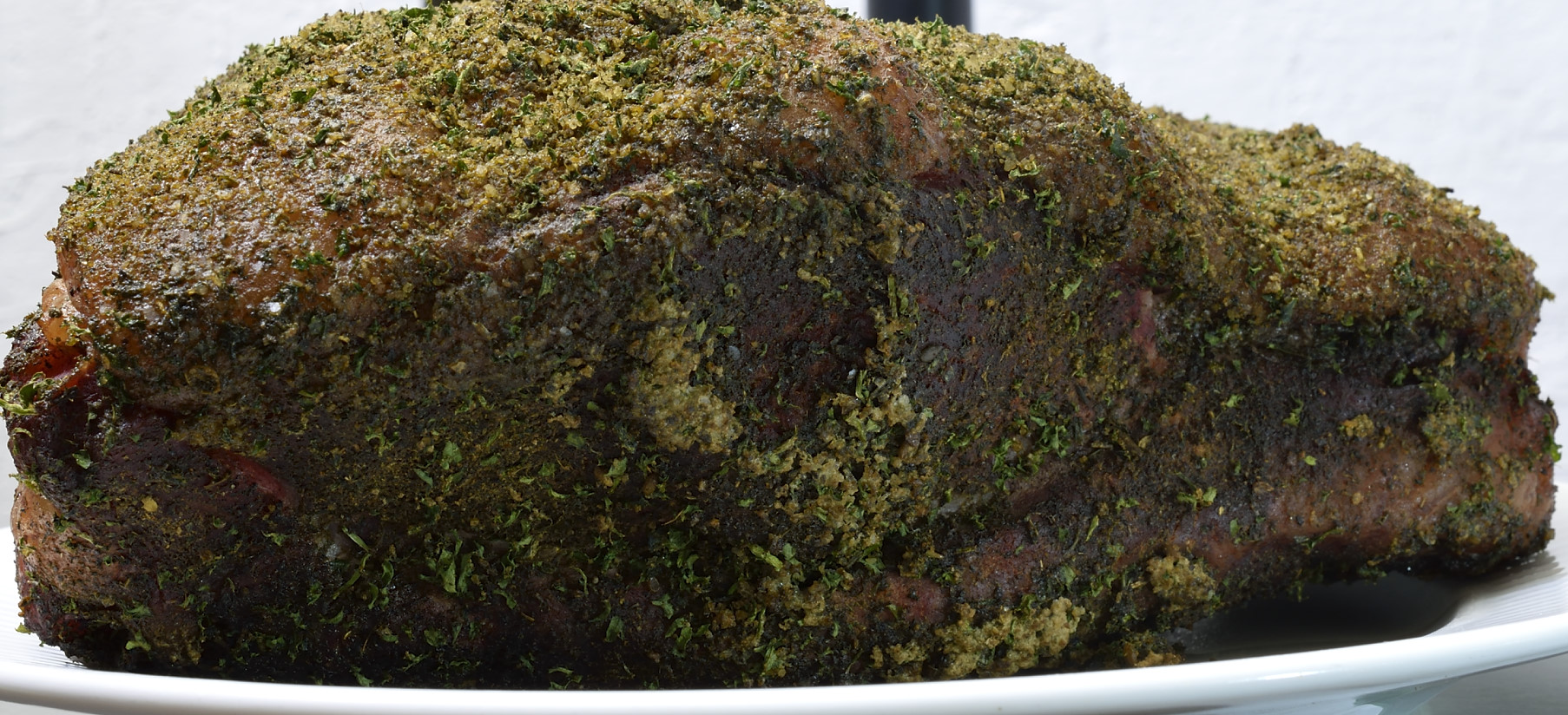 Above: the roast seen from the nerve end. Below: the roast seen from the rib eye end--you can see the distinctive difference in shape.
Above: the roast seen from the nerve end. Below: the roast seen from the rib eye end--you can see the distinctive difference in shape. 
Service
Now for the fun part!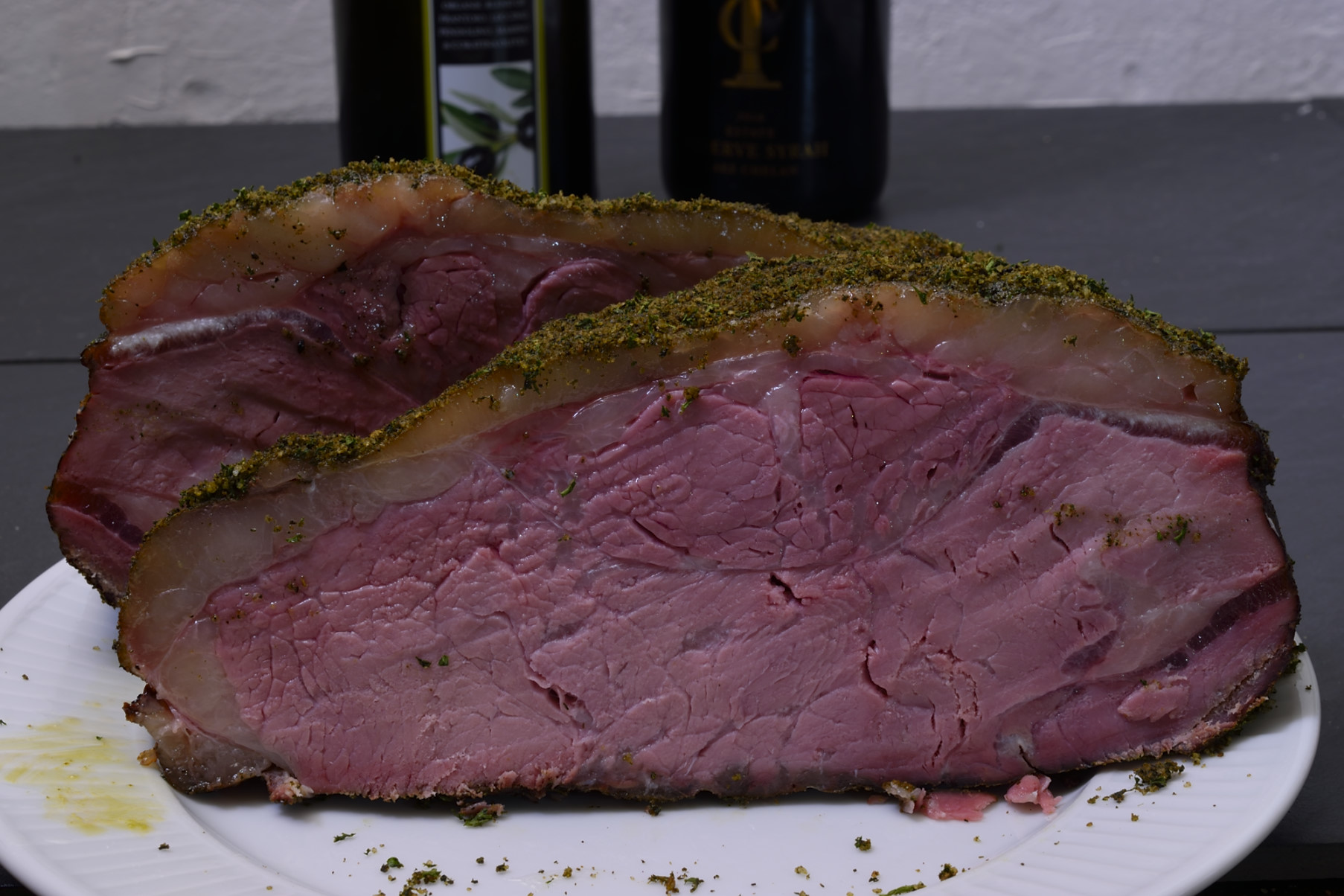 Once the fully tenderized roast has been removed from the smoker, it can be sliced thick to closely resemble the much higher priced Prime Rib entree.
Once the fully tenderized roast has been removed from the smoker, it can be sliced thick to closely resemble the much higher priced Prime Rib entree.  Above: the connective tissue is now visible, but has been reduced to a point where it is no longer detectable to your steak knife or your palate.
Above: the connective tissue is now visible, but has been reduced to a point where it is no longer detectable to your steak knife or your palate. 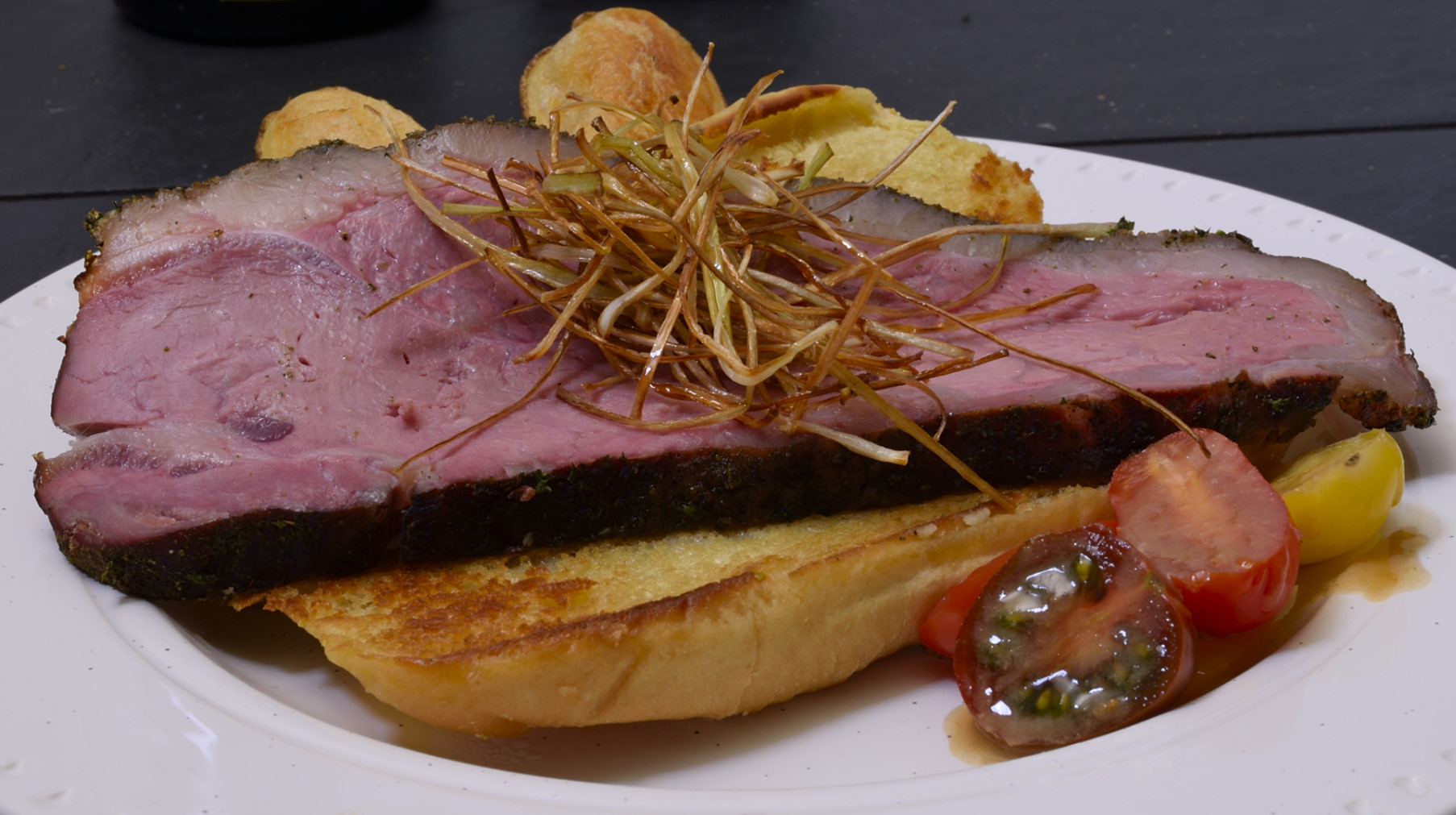 This novel "sandwich" presentation elevates the dish to a whole other level. Grilled French roll...
This novel "sandwich" presentation elevates the dish to a whole other level. Grilled French roll... 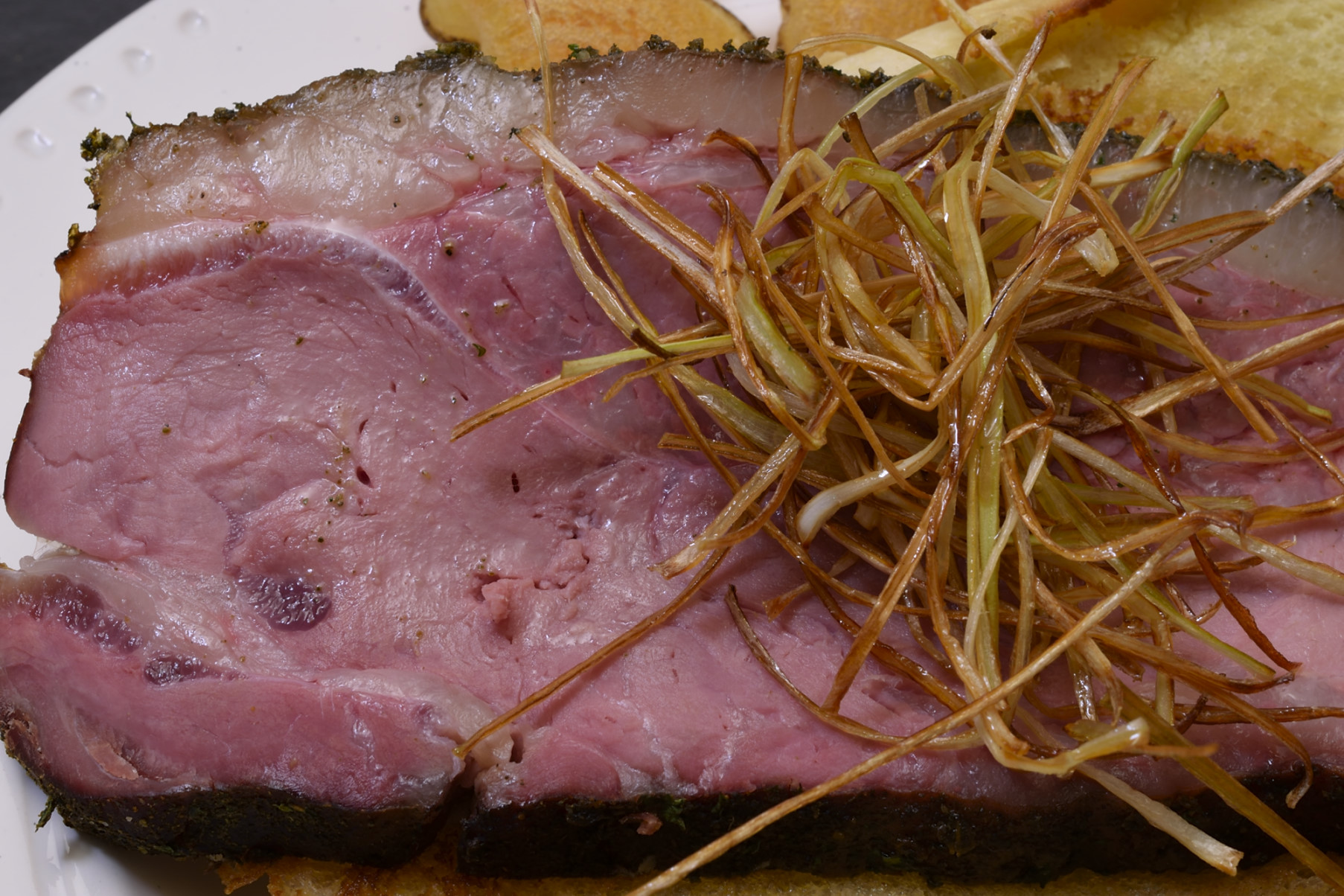 crisped leeks and typical sandwich style accouterments bring color and altitude.
crisped leeks and typical sandwich style accouterments bring color and altitude. 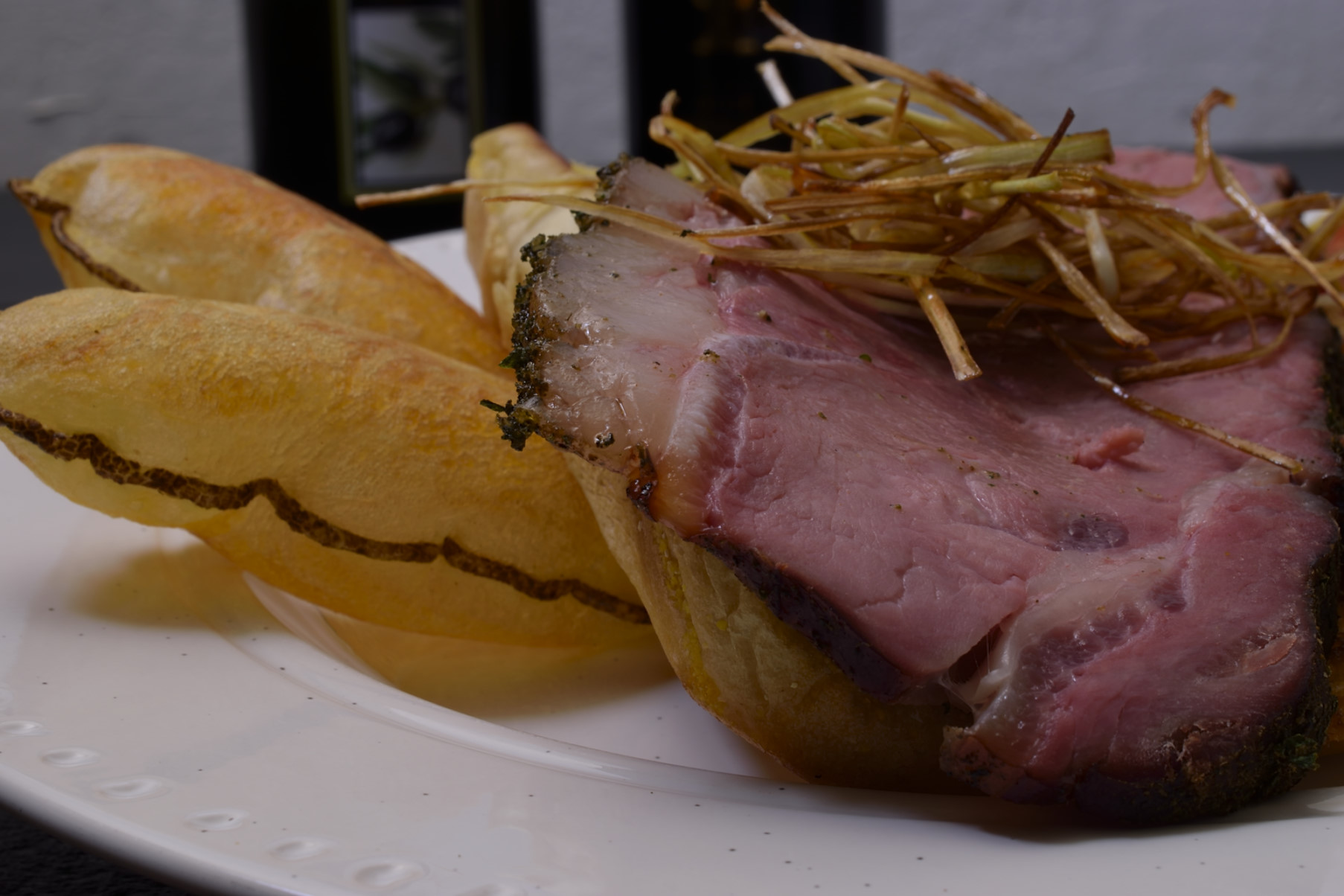 A simple potato chip is transformed into Pommes soufflées. Fun to make, if you have the time and the patience!
A simple potato chip is transformed into Pommes soufflées. Fun to make, if you have the time and the patience! 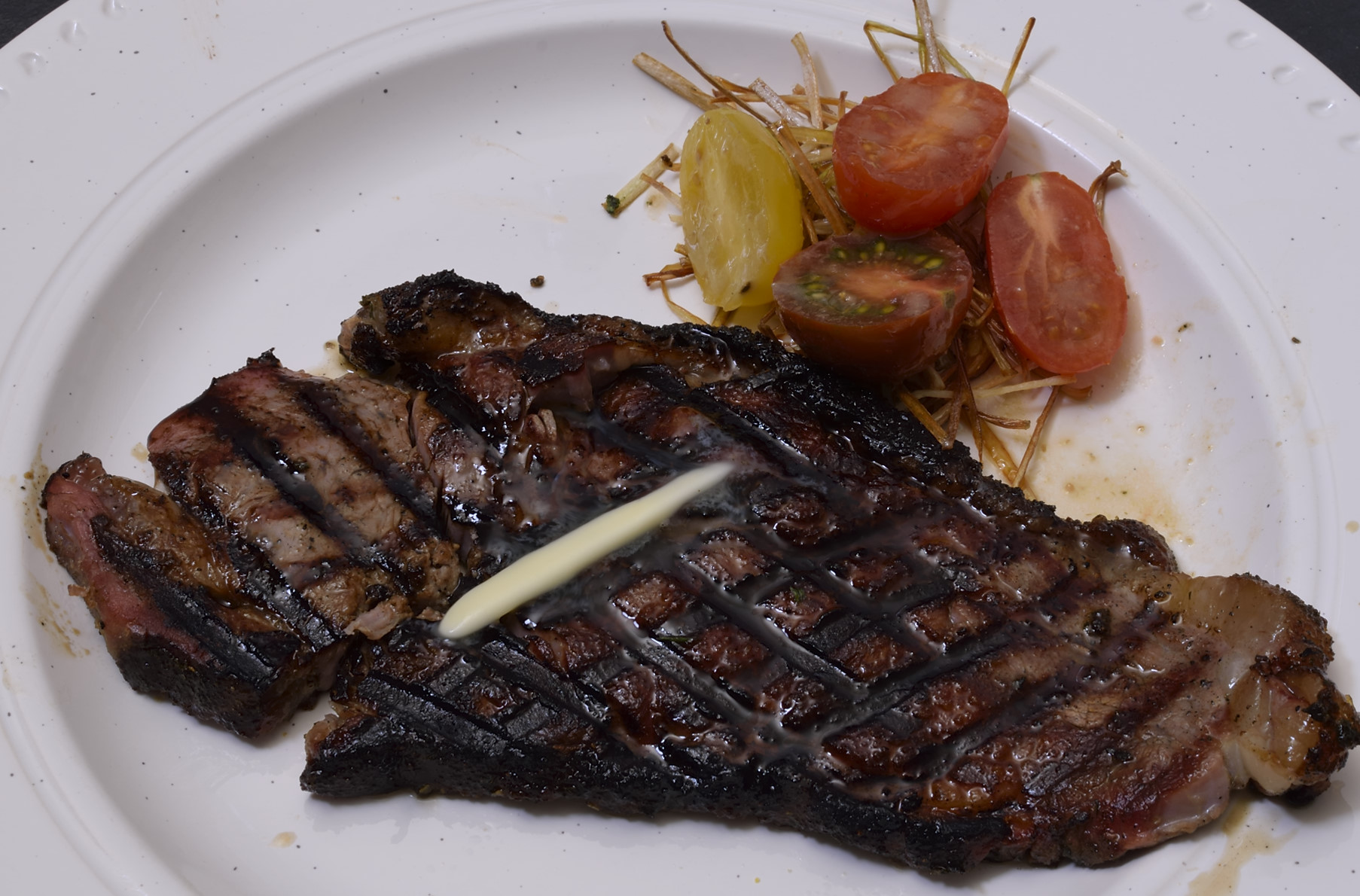 "Burnt and Buttered." Assuming you find yourself with some "leftovers," make sure you store what's left of your roast safely at 40 F/4 C. The next day, you can cut thick slices, coat the exposed surfaces with egg whites and sprinkle with our special Cajun black spice linked HERE.
"Burnt and Buttered." Assuming you find yourself with some "leftovers," make sure you store what's left of your roast safely at 40 F/4 C. The next day, you can cut thick slices, coat the exposed surfaces with egg whites and sprinkle with our special Cajun black spice linked HERE. 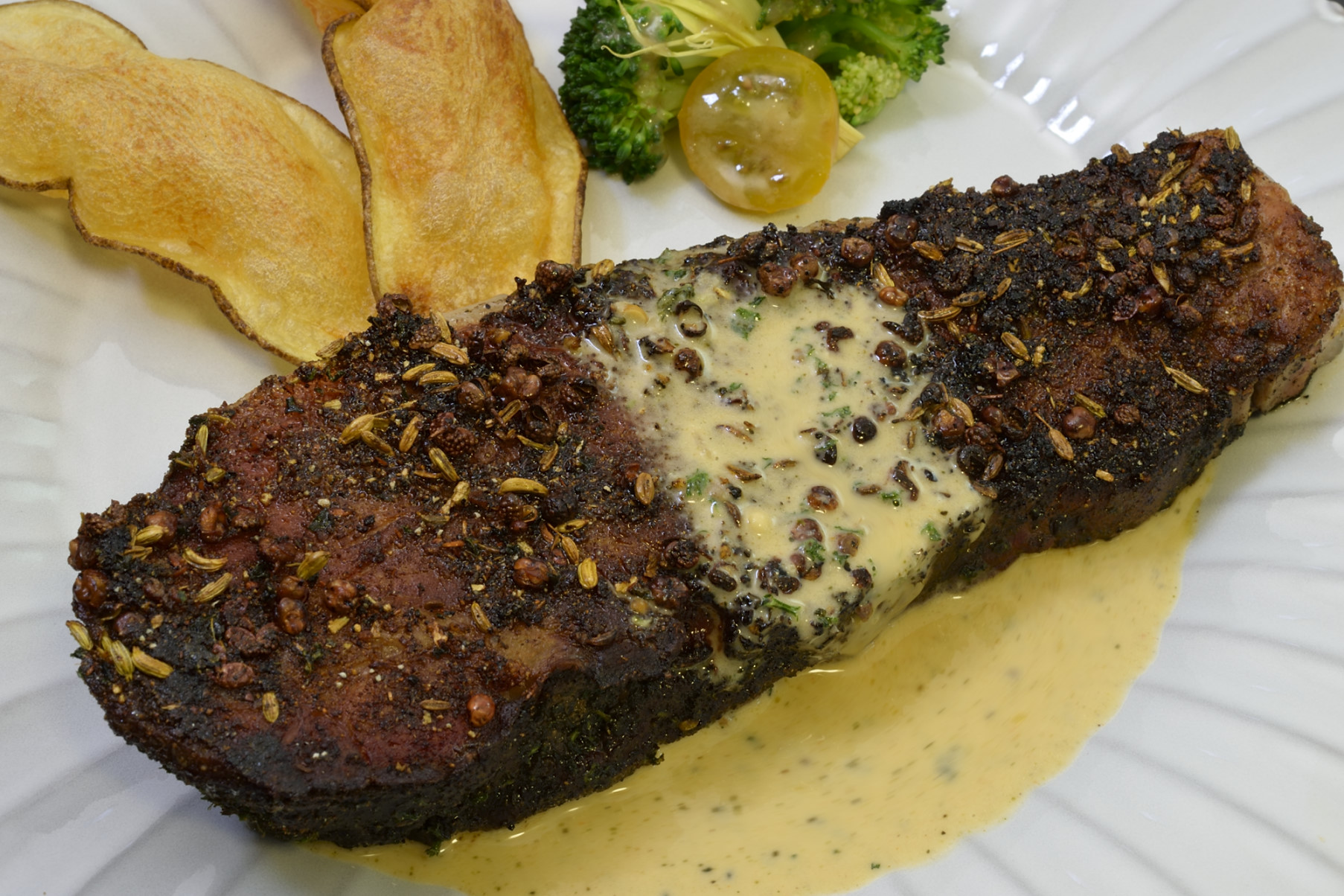 For this presentation, we added a few Sichuan peppercorns for an extra kick, and a simple BUTTER SAUCE from our own recipe files using the juices collected from the pouch.
For this presentation, we added a few Sichuan peppercorns for an extra kick, and a simple BUTTER SAUCE from our own recipe files using the juices collected from the pouch. 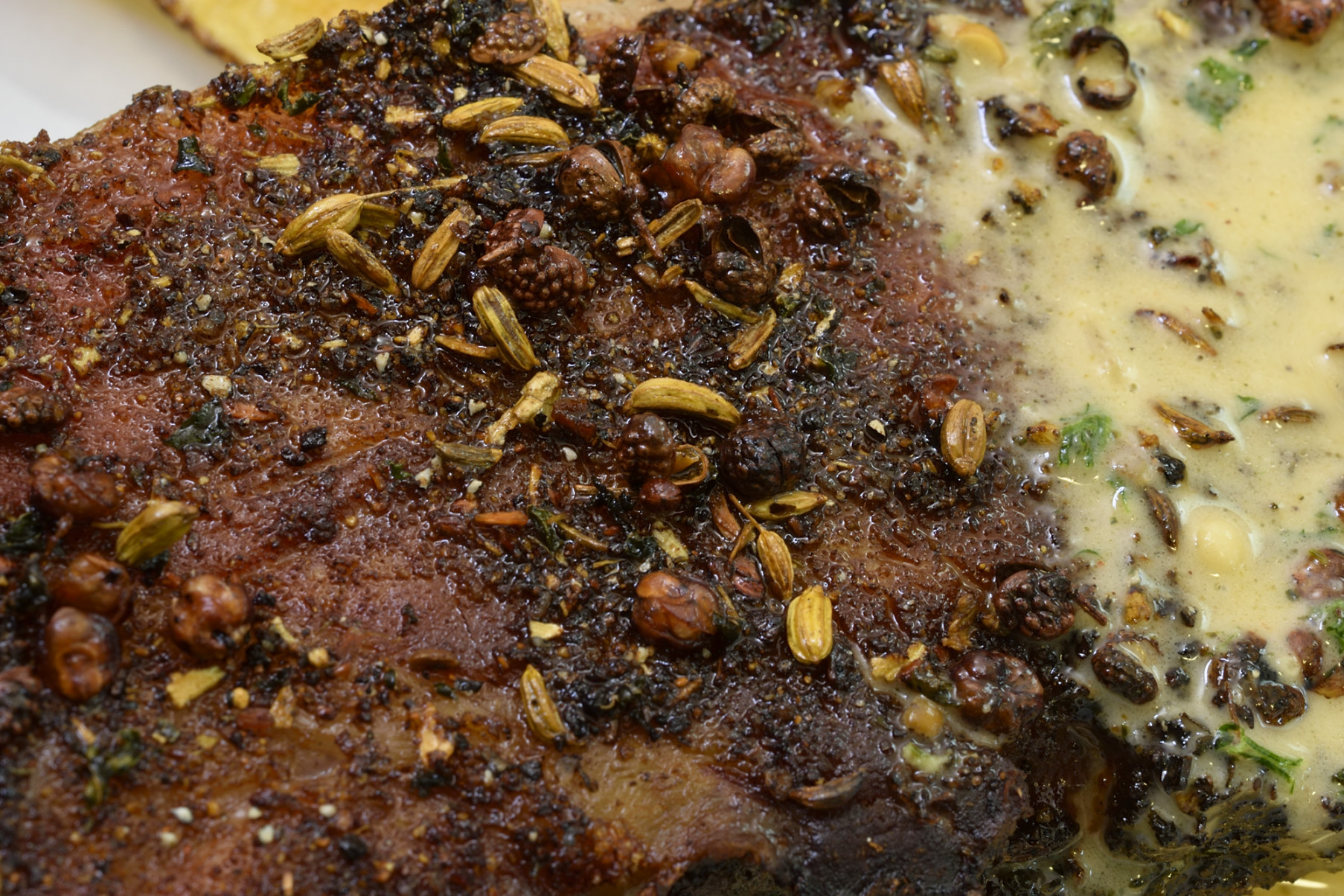 One caution--after the roast has been smoked and then cooled (again), subsequent treatments will limit the steak's ability to appear "medium rare." This is not a flaw in sous vide, but a characteristic of myoglobin, which is what creates the red appearance of rare beef, lamb, etc. Myoglobin is temperature dependent, but it is also time dependent, and has a tendency to dissipate during the retherming process, as seen below. Even so--very tasty!
One caution--after the roast has been smoked and then cooled (again), subsequent treatments will limit the steak's ability to appear "medium rare." This is not a flaw in sous vide, but a characteristic of myoglobin, which is what creates the red appearance of rare beef, lamb, etc. Myoglobin is temperature dependent, but it is also time dependent, and has a tendency to dissipate during the retherming process, as seen below. Even so--very tasty! 